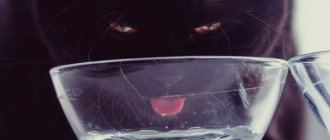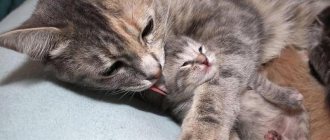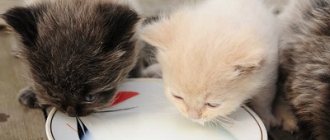Normal kitten weight
The first six months after birth are the most important in a kitten's life. It is during this period that you can understand how strong his physique will be in adulthood, as well as how much weight he will be able to gain.
There is no simple answer to the question of how much a British cat should weigh during the first six months of life, since each period has its own characteristics of development and weight gain. There is a special table that shows the weight of an animal of this breed depending on age. It is easy for British owners to navigate and check the development of their pet.
Much also depends on the proper care of the animal and its diet. Both factors have a strong impact on the weight of the pet.
The first days after birth
Newborn babies of Scottish and British breeds weigh almost the same. Their mass is quite large compared to other species, since adult pets are large individuals.
A kitten of this breed at birth will have a body weight in the range of 70–130 g. During the first 7 days of life, they gain weight well, becoming 1.5 times heavier.
In the first week after giving birth, the female should eat a lot of vitamins and minerals so that the offspring, through mother's milk, can receive everything they need for their growth and development.
In the second week
With proper and nutritious nutrition, a Briton should weigh 110–150 g by the second week of life. In just 7 days, this figure can increase by 1.5–2 times.
During this period, kittens are inactive and blind. They eat and sleep a lot, which contributes to good weight gain. During the second week, the animals reach 210 g. Some specimens were even able to gain 420 g. During this time, the babies gradually become more active and mobile. Some may even have their eyes opened.
Up to a month
After two weeks and up to 1 month, babies are gradually introduced to complementary foods. Its administration depends on the abundance of breast milk. The optimal time to start complementary feeding is 3–4 weeks. You should include canned cat food, chicken or beef, cottage cheese, sea fish, and a boiled egg (yolk only).
By the first month, the babies will gain another plus 250 g. Large kittens can grow well at this age and already weigh more than half a kilogram. This will be a normal indicator. It is optimal that by the 5th week the animals weigh on average about 600 g. At 8 weeks this figure can already exceed 700 g.
Three months
With proper nutrition, a British baby should weigh about 1 kg by 3 months. Every day the set is about 100 g. During this period, the body weight of animals depends on their gender. So, a cat should normally weigh 1–1.5 kg, and a cat should normally weigh a little more than 1.5–2 kg.
At this time, pets can still feed on mother's milk. Therefore, the cat should receive a balanced diet rich in vitamins and minerals. Babies should vary their feeding.
From natural products they need to be given:
- smoked sausages;
- pork, chicken;
- fermented milk products;
- river fish.
When it comes to dry food, you need to buy products from well-known companies (for example, Hills, Orijen, EVO), specially designed for growing young animals.
Four months
By the end of the third and beginning of the fourth month, British cats should weigh on average 1.7–2.4 kg, and male cats 2.1–3.9 kg. Over 4 months, the average normal weight for representatives of this breed is 2 kg. A lot here depends on diet. If your pet weighs more than 4 kg, you need to reduce the amount of food to prevent obesity.
Five months
During the fifth month, the animal usually increases its weight by 1.5–2 times. Normally, British people at this age should weigh 4.5 kg. To transform into an adult cat, your furry pet should gain the same amount.
Getting used to a new place and training to a tray
At first, the kitten will miss its previous home, meows at night, pick it up and stroke it, talk to it. Caring for British kittens at 2 months is exactly like this. At night, you can put him on a warm heating pad, wrapping it in a towel (this will remind him of his mother or the presence of other kittens nearby). Take your time, let the Brit get comfortable.
shutterstock
If the animal was purchased from a nursery, they are often already litter box trained. If not, then it won't be difficult. After feeding, take your Brit to the toilet. It is better to fill the tray with wood filler. He will like it there and will quickly remember where to go. The tray should always be clean, this is the key to avoiding embarrassment. If there is an embarrassment, then it is worth punishing the kitten.
This will develop a conditioned reflex and after the third time the kitten will understand that this is not worth doing. Never allow a cat's unacceptable behavior to go unpunished.
Generally accepted weight standard
In order for representatives of the British breed to develop harmoniously in the first six months of life, their weight parameters must be compared with a special plate. According to it, the generally accepted weight standard for these animals, depending on age, is as follows:
- newborn kittens: boys – 70–140, and girls – 60–140 g;
- first week: males – 140–260, and females – 110–250 g;
- second week: boys – 340–400, and girls – 150–360 g;
- third week: males – 400–630, and females – 210–420 g;
- fourth week: boys – 550–740, and girls – 250–600 g;
- second month: males – 1–1.7 kg, and females – 450–900 g;
- third: boys – 1.5–2.5, and girls – 1–1.5 kg;
- fourth: males – 2.1–3.9, and females – 1.7–2.4 kg;
- fifth: boys – 2.6–4.3, and girls – 2.2–2.9 kg.
At six months, British cats should weigh 3–5.4 kg, and cats should weigh 2.3–3.6 kg. At 1 year, the normal weight of a male should be 4.5–8 kg, and that of a female should be 2.5–5.5 kg. A castrated boy at this age should weigh 4.5–9.5 kg, and a sterilized female should weigh from 2.5 to 6 kg.
To obtain more accurate indicators, animals must be weighed at the same time. Typically, representatives of this breed normally gain about 100 g daily.
For such a kit, it is enough to correctly prepare a diet and keep the animal in normal conditions, as well as periodically show the kitten to a veterinarian. This is especially important if the Briton begins to gain weight quickly.
How much a British breed kitten will weigh directly depends on proper nutrition and care for it. Therefore, after birth, an animal needs complete and proper care, because it is in the first months of life that the foundations of good health are laid.
Safety first
Take care of the safety of the chosen toy for your kitten, because they are like children. There should be no parts that a Briton can swallow: excess fluff, elastic, shiny, small beads. Toys should be soft and made of good fabric. Avoid purchasing hard or sharp toys.
Make sure everything in the house is safe for the kitten:
- Close access to all the cracks where a Briton can climb in and not get out until he grows up;
- Keep the bags out of the reach of kittens, because they are such little naughty creatures, while playing, they can get stuck there and suffocate;
- Cover your trash at night. A British person will not be tempted to find and eat a sausage roll;
- Place nets on the windows so that the Briton does not stare at the bird and fly away with it;
- Don’t leave threads, raindrops, or balls in a place accessible to a Briton; he can easily eat it all;
- While the Briton is very small, be careful. He remembers that you may not notice him, step on him, sit down, lie down;
- Before the first vaccination, try to limit your pet’s contact with other animals and various objects from the street;
- Do not leave chemicals or detergents open or unattended;
- It is better to keep dry food in the pantry away from the cat.
Meeting all family members
Children love animals very much and show great interest in them. Tell your child how to properly pick up a cat, how he shows his dissatisfaction by wagging his tail, and that you shouldn’t squeeze him too hard and drag him around the house.
Perhaps you have another animal at home? Then you should initially not introduce the new guy to the old one for a couple of days. The new one will still get used to it, but the old resident will already feel the emergence of a new one.
At the same time, pay sufficient attention to both the first and second pet so that jealousy does not arise. Arrange a meeting with them in a few days
They need to be in the room at this moment, and each of them should have a place to retreat, in case something happens. If an undesirable reaction occurs, limit contact with the animals for a couple of days and introduce them again.
Visual inspection
To determine the condition of the animal, it is necessary to carefully examine its physique. The condition of the limbs and abdomen is determined when looking at the profile, the lumbar region and waist are assessed when viewed from above. The weight of a cat can also be “calculated” by manual palpation. To do this, the area of the ribs is felt with your fingers. Moreover, if the bones stick out at the slightest pressure, then the animal is malnourished; if you need to make an effort to palpate them, then, most likely, the pet is obese.
After the ribs, the waist and abdomen area is assessed
In cats, it is very sensitive, so you must be careful when palpating. If you run two palms from the waist to the pelvic bones, you should get an hourglass shape
If this sensation does not arise, then the cat is most likely overweight.
Next, the abdomen is examined. Softness should be felt under your fingers. But if it hangs down a lot or is swollen, then nutritional adjustments are necessary. A sunken belly indicates a lack of nutrition or illness.
Development in the third week
During the third week, all kittens' eyes open. However, vision is not yet good enough to navigate in space. It is necessary to monitor all physiological changes to ensure that the development of kittens corresponds to their age and to promptly eliminate irritating factors that may interfere with normal growth.
The main stages of development of newborn kittens take place in the first three weeks, as their body is actively growing and all the organs of smell and touch are formed. It is at the age of three weeks that kittens first try to stand on their paws and their teeth appear.
The formation of the jaw will take up to two months. From the third week, you can safely accustom the baby to your hands, constantly play with him and stroke him, and in order to let the pet know that the owner is also one of his friends, in addition to the other kittens and the mother.
Is it possible to identify a Briton by his behavior?
The character of a British cat is also a serious marker of the species in question. It begins to manifest itself in childhood, and over time acquires all the required features:
- autonomy and independence;
- desire to be alone;
- habit of sleeping a lot;
- tolerates long absence of the owner from the house without any problems.
All basic character parameters can be adjusted only in childhood, but you should not expect that the British dog will become sociable, affectionate and strive for constant communication with the owner.
In the early period, ground rules for living together are laid down and red lines for unacceptable behavior are drawn. If everything is left to chance, the kitten will eventually turn into an aggressive cat that will bite, scratch and make its own rules in the house.
British kitten 2 – 3 months
Kittens feed themselves, go to the toilet, and play. They are very curious and it is worth taking care of their safety: close the windows, remove poisonous plants, dangerous sharp toys, threads, buttons. They suck a cat out of habit; they will do this until they are weaned or the cat stops letting them come to them. The paws of kittens lengthen and no longer resemble bear cubs, all this is due to uneven development. Character begins to emerge. It is worth spending more time raising children, teaching them to use a comb and a scratching post. Two months - it’s worth carrying out the first deworming and getting vaccinated, more about vaccinations here. Three months – repeated vaccination against viral infections and rabies vaccination are carried out. After three months, the kitten is considered socially adapted and can move to a new home.
How not to buy a fake British
A purebred cat cannot be cheap. If someone offers a “real” British cat for ridiculous money, then the kitten is not British after all. Only conscientious breeders and reputable nurseries give a guarantee of the “quality” of the breed.
They value their reputation very much, kittens are sold only after reaching the age of 3 months, and at the same time they are very interested in what hands their pets fall into.
Those wishing to purchase a purebred British cat select options in advance, consider alternative scenarios, and even first meet the parents of the future kitten.
It has been noticed that the English breed is most favored by wealthy and independent people who spend a lot of time outside the home and are accustomed to having all the best around them. In such a situation, a British kitten would be an ideal option.
He is beautiful, independent, and will never get bored or offended by his owner for long hours of loneliness. A complete coincidence of characters and desires is the best guarantee of peaceful and happy leisure time together.
I like7I don't like1











